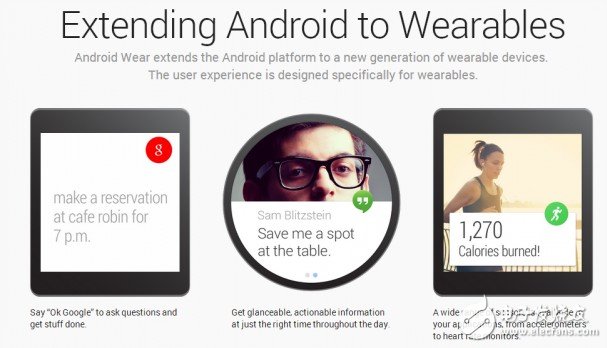Google’s implementation of Google TV in 2010 has had limited success, and Chromecast, which switched to $35 in 2013, immediately sold off and cut into the digital home market in a modified way. Similarly, Google proposed Google Glass in 2012, which is almost two years old. The promotion of Google glasses is quite limited. Nowadays, Android Wear can be seen as a similar transformation attempt to cut into the wearable electronics market.
Google’s strategy for hardware products has often swayed. Google TV is working with Logitech and Sony, but the low-cost Chromecast is its own brand, but it is rumored to open Chromecast technology. Similarly, Google Glass Explorer is priced at $1,500 and is being promoted by Google. However, Android Wear (for smart watches) at a lower price tends to work with the industry. LG and Moto (Google own, not sold to Lenovo) have already Launched, and announced that it will also include Samsung, ASUS, HTC, and more importantly, Fossil. Fossil is known for its traditional watch. In the past, it also supported Microsoft's SPOT in 2004. The addition of Fossil is meaningful and shows the smart watch market. Reaffirmed.

The technical nature of Android Wear
Android Wear is essentially a technology similar to the LiveView technology promoted by Sony Ericsson in 2011. The smart watch made with LiveView is also called Micro Display or Android Remote. The LiveView smart watch is not independent. Instead, it communicates with the Android smartphone and becomes another way to operate the mobile phone. When the user operates the smart watch, it is equivalent to operating the mobile phone. The mobile phone has a display and is also displayed on the watch. The watch becomes a kind of “assistance device†similar to the Bluetooth headset. , through the headphones, answering through the headphones, the phone can be placed in the pocket. In 2013, Sony also launched the second generation of LiveView smart watches, but renamed SmartWatch 2.
Android Wear is positioned as a proxy, and its hardware specifications are quite simple, as long as 280 x 280 (can only be made into a square display) or 320 x 320 (square or round) resolution, 512MB of memory, 200MB of storage space can be achieved. The smartphones of this size are currently only priced at NT$1,000. It is obvious that Android Wear's smart watches will be very affordable.
The Android Wear software technology has not changed much. Based on Android 4.4.2, the API level is still at Level 19. For software developers, it is mainly to learn to write the notification message that was presented on the mobile phone and display it on the watch.
Another feature of Android Wear is support for Google Now, the voice recognition operation, which is generally the same as Google Glass, and the touch and display should be different from Android Wear and Google Glass. Google Glass only has side strips that can be touched. It can only slide back and forth with the beat point (one-dimensional), but Android Wear's output interface Context Stream can slide up and down (two-dimensional), while the input interface Cue Card can only go up (one-dimensional). In terms of resolution, Google Glass is 640 x 360, which is higher than Android Wear.
Market impact of Android Wear
Once Android Wear debuts, except for Sony's LiveView, the Pebble watch will probably be affected. Pebble claims to have sold 400,000 watches (only 1 year sales, which is better than MetaWatch's cumulative sales of 250,000). It can support a variety of smart phones such as iOS, Android, Windows Phone, etc. In January 2014, it also cooperated with Merced-Benz. In the future, Pebble watches can be used to control cars.
But the Pebble table has low resolution (144 x 168), black and white only (sharp memory LCD), and Android has more than 70% of the smartphone market. Neutral mobile phone support is not of much value, and The sales of 400,000 yuan also do not have a solid preemption.
It is worth noting that Samsung originally launched the independently operated Galaxy Gear in September 2013, but it has obviously given up. In addition to the new smart watch to use TIzen operating system, it is estimated that Android Wear smart watch will also be implemented.
Once Android Wear is firmly established, the next two possibilities may be that with Moore's Law continuing to advance, Android Wear will move toward independent computing in the future, no longer relying on smart phones, and form specifications and price levels with the original generation-assisted smart watches. Positioning.
Or, Android Wear will add speed sensors and related sensors to become sports and health recorders, so the combination of smart watches and smart bracelets will be combined (LG Lifeband Touch has this meaning), and it is estimated that there will be no increase in price, the future A simple smart bracelet can only be developed at a lower price, or even without development space.
We are the manufacturer of producing energy saving ceiling lamps. There are three color temperatures with cool white, warm white and natural white of down lights. Available RD/BL/GR/PK with multi-color options for you. The unique features of LED Down Light are: CRI>80, PF>0.5. These ceiling lamps are mainly apply to hotel, restaurant, office, shopping mall, super market, residence, hospital, coffee bar, club, staircase, entrance and toilet etc. Specially molded led down light in high grade pure polycarbonate material and with aluminum heat sink brings superior insulation performance, cost effective, easy installed, durable illumination on your ceiling. Such simple design PC led down lighting creats a very good light ambience after it is installed in home, hotel hall and supermarkets etc, it is a popular choice for ceiling lighting facility.
Smd Downlight,Smd Led Panel Downlight,Led Smd Downlight,Smd Downlight Housing
Jiangmen Lika Lighting Electrical Appliances Co., Ltd , https://www.lika-led.com
